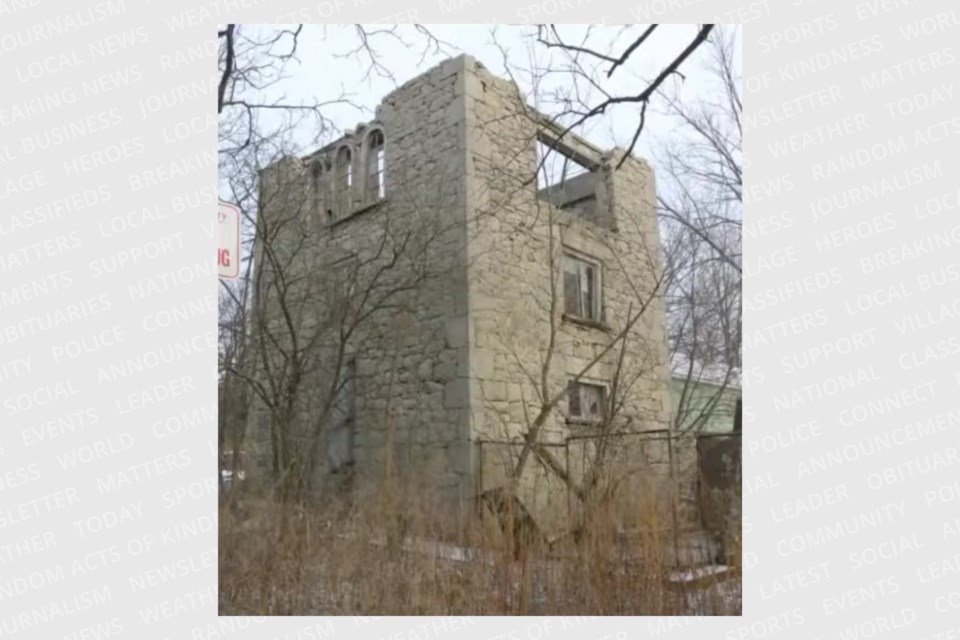A stone tower at the Forbes Estate will be dismantled, stored and moved to a new home at Jacob’s Landing Park after city councillors voted in favour of a staff recommendation to save the structure following more than two hours of debate Tuesday.
Staff recommended moving the tower and designating it under the Ontario Heritage Act as a way to improve public access to it in advance of redevelopment of the property at 171 Guelph Ave.
A few stone garages on the site will be demolished and the stately, brick Forbes House, built in 1912 by local industrialist George Forbes, will get a heritage designation.
Polocorp Inc. sought the city's approval last year to redevelop land once owned by town founder Jacob Hespeler.
A plan of subdivision for the 13-acre property would see the construction of 185 homes on the site, but since council deferred a decision on the application last July, it will be before the Ontario Land Tribunal next month for an appeal hearing.
The stone tower, built prior to 1880 and believed by some to be a “dovecote,” is essentially a barn designed to house pigeons, doves and other poultry for human consumption.
The rarely surviving farm buildings are considered significant in Ontario because only two known dovecotes have survived demolition, one at Dundurn Castle and the other at Auchmar Estate, both in Hamilton.
One heritage advocate who is convinced the building is a “dovecote” is Karen Scott Booth, a member of the Cambridge branch of the Architectural Conservancy of Ontario.
She made a presentation at Tuesday’s meeting insisting that alone meets the criteria for designation and protection.
“So why are we considering dismantling, removing and relocating?” she asked.
Citing guidelines for the conservation of historic structures, which calls for “minimal intervention” as a way to “recognize each historic place as a physical record of its time, place and use,” Booth framed the ACO’s opposition to the city’s recommendation to move the stone tower to Jacob’s Landing.
“The recommendation…does not respond to these accepted guidelines,” Booth said.
She called it the “least desirable approach to conserving significant cultural heritage resources” and said the region’s own heritage advisory committee suggests the stone tower be “retained in situ” within the proposed plan of subdivision or within a green space dedicated to the City of Cambridge.
The land at 171 Guelph Ave. was once the site of an agricultural complex owned by Jacob Hespeler, one of the key founders in the development of the Town of Hespeler.
Staff considered keeping the stone tower in its current location as part of a park within the condominium development plan for the property, but said because it is located in a low-lying area that would discourage public access, decided it’s not the best option.
Booth said a grading issue around the tower, which raised concerns about public safety and accessibility, could be resolved through design.
“The rediscovery of this dovecote is a true architectural and historical gem in our community,” she said, urging council to take advantage of the opportunity to retain all of the historic elements of the Forbes Estate.
Rebecca Sciarra, a heritage consultant hired by the developer, said the tower may have been used to house fowl but there is insufficient historical record or physical evidence to determine it is in fact a “purpose-built dovecote.”
She did, however, say it should be preserved because of its historical relevance to Hespeler, its design and craftsmanship and agreed with the staff recommendation to relocate it to a publicly accessible trailhead and “implement a stabilization and repointing program to ensure its long-term preservation.”
The city is recommending it be “adaptively reused as an observation tower with accessibility features” once it is moved to Jacob’s Landing park.
A preliminary estimate of the cost is approximately $350,000 based on 2022 pricing, reads the report. The city would be responsible for assisting with obtaining the required permits and preparing the new location for the tower at a cost of approximately $100,000.
In voicing her support for the staff recommendation to move the tower, Mayor Kathryn McGarry said its historical context will be weakened once the subdivision is built around it and she sees little value in keeping it where it is. She feels it could be better interpreted for its historical value in a public setting.
Coun. Jan Liggett, however, said she thinks moving the tower would “do irreparable harm” to its historical designation and expressed skepticism that it would even happen.
“To move that building, you wouldn’t even get it for half a million. It’s going to cost a lot more than that,” she said.
Asked by Coun. Pam Wolf if the city has the power to insist the developer pay for the reconstruction, city heritage planner Abraham Plunkett-Latimer said it can’t be required under the Ontario Heritage Act, but it could be a condition of the subdivision approval.
The heritage act could also give the city the power to insist the developer stabilize the structure in the meantime to prevent further deterioration under the property standards bylaw.
Coun. Shannon Adshade said he’d prefer to see the tower in a public space and believes heritage staff when they say it can be relocated.
Council eventually voted in favour of the staff recommendation to move the tower, designate the Forbes house as a heritage property and demolish other stone structures on the site.



